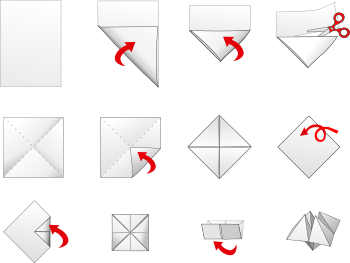 |
| How to fold a paper fortune teller 12 steps (Photo credit: Wikipedia) |
The Book - fold a piece of paper (rectangular or square) down the middle vertically making certain the opposite edges line up one on top of the other. For many origami figures, you will need to add another book figure - open the paper and make another fold across the middle horizontally again, making sure the edges lie one on top of the other. If you don't open the book before making the second fold you end up with the handkerchief fold which gives you a small square with four layers of paper one on top of the other.
The Cupboard - using a square piece of paper make the book fold then open the paper and take each outside edge and fold it to the centerline. By bringing each edge over to the next line you will end up making even more equal vertical stripes.
The Fan - with either a square or rectangular piece of paper fold a Cupboard. Open the Cupboard; three valley folds (downward angles) divide the Cupboard into four equal-sized strips. Turn the figure over; fold the edges onto the outer lines making two mountain folds. Turn the figure over and refold the Cupboard. Turn the Cupboard over once again and fold the edges into the middle line resulting in two mountain folds (upward angles). Fold up the figure and you have made an eightfold fan with alternating mountain and valley folds, also called an accordion fold.
The Lattice - make a Cupboard from a square piece of paper. Open the Cupboard and repeat the procedure folding in a horizontal direction. Open the paper and you have the Lattice. It is 16 equal-sized squares used to make boxes, houses, and simple animal bodies.
The Shawl - Make a diagonal fold down the middle of a square piece of paper making sure your edges and corners lay on top of each other. If you need a second diagonal fold open the sheet of paper completely before starting the second fold to get a more exact line.
The Envelope - using a square piece of paper make diagonal folds down the center in both directions. Open the paper and bring each corner up to the middle.
The Picture Frame - First make the Envelope. Open the envelope; turn each corner up to the outer diagonal line. Now fold the four corners inward and you have a picture frame.
Heaven and Hell - Fold an Envelope. Turn the Envelope over and fold each corner up into the center again. Turn the figure over and you will see pockets on the other side. Open these pockets. This figure was dubbed Heaven and Hell because it was usually made on red and blue paper. This particular fold can be used for making simple hand puppets and animal heads




